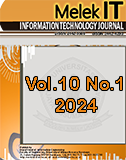THE DESIGN OF WEB-BASED MEAT STOCK MONITORING SYSTEM AT OREN FROZEN FOOD SHOP USING CODE IGNITER FRAMEWORK
Main Article Content
Abstract
The rapid advancements in science and technology today are expected to produce an information system that supports the smooth tracking of meat stock in stores. Currently, the meat monitoring system at Oren Frozen Food Store is still managed manually to handle the amount of meat stock in the freezer, often resulting in issues with stock tracking. Data errors can cause significant losses for Oren Frozen Food Store. The web-based system developed uses the waterfall method, with PHP programming language and MySQL database. The author also utilizes the CodeIgniter framework in creating this web system. This research aims to build an information system that can be used to manage the monitoring of meat stock data at Oren Frozen Food Store. It is hoped that with this system, store owners will find it easier to manage meat stock data and reduce human errors in the data management process at Oren Frozen Food Store. The black box testing results show that all features work well, including login, home, product data, stock notifications, adding product data, product details, updating product data, category data, purchase data, reports, customer data, customer login, customer home, and customer shopping history.
Downloads
Article Details

This work is licensed under a Creative Commons Attribution-ShareAlike 4.0 International License.
How to Cite
References
S. Assauri, “Manajemen operasi produksi,” Jakarta: PT Raja Grafindo Persada, pp. 69–80, 2016.
F. SITTI, “Rancang Bangun Sistem Pengelolaan Data Kelurahan Tombolo Berbasis Web,” UNIVERSITAS ISLAM NEGERI ALAUDDIN MAKASSAR, 2018.
D. Ariyanto and E. Wahyuningtyas, “Sistem Penjualan Furnitur Berbasis Web Pada Cv. Ferdiosa,” MelekIT, vol. 5, no. 2, 2019.
S. Syidada and H. P. Anggraini, “Sistem Informasi Penjualan Seprai Pada Toko Salsabila Seprai,” Melek IT: Information Technology Journal, vol. 9, no. 1, 2023.
A. Firman, H. F. Wowor, and X. Najoan, “Sistem informasi perpustakaan online berbasis web,” Jurnal Teknik Elektro dan Komputer, vol. 5, no. 2, pp. 29–36, 2016.
Y. Wahyudin and D. N. Rahayu, “Analisis Metode Pengembangan Sistem Informasi Berbasis Website: A Literatur Review,” Jurnal Interkom: Jurnal Publikasi Ilmiah Bidang Teknologi Informasi dan Komunikasi, vol. 15, no. 3, pp. 26–40, Oct. 2020, doi: 10.35969/interkom.v15i3.74.
L. Mutiari and E. Wahyuningtyas, “Rancang Bangun Sistem Informasi Point of Sales Berbasis Website Pada CV. Lulus,” MelekIT, vol. 7, no. 2, 2021.
R. Dwi Darmawan, T. Nur Irawan, and S. Syidada, “RANCANG BANGUN WEB PROFIL SEKOLAH SEBAGAI MEDIA PROMOSI SMP KARTIKA IV-10 SURABAYA,” Melek IT, vol. 8, no. 1, pp. 67–76, 2022.
D. F. Rahmatullah and S. Syidada, “Sistem informasi penjualan dan pemesanan import barang berbasis web PT Bumi Jaya,” Melek IT: Information Technology Journal, vol. 8, no. 2, 2022.
L. Alfat, A. Triwiyatno, and R. R. Isnanto, “Sentinel web: Implementation of Laravel framework in web based temperature and humidity monitoring system,” in 2015 2nd International Conference on Information Technology, Computer, and Electrical Engineering (ICITACEE), 2015, pp. 46–51.
E. Widyawati and A. Kurniawan, “Rancang Bangun Aplikasi Kependudukan Berbasis Web Di Desa Kedungrejo Waru-Sidoarjo,” Jurnal Manajemen Informatika, vol. 6, no. 1, pp. 171–179, 2016.
K. A. Rajabi and E. Wahyuningtyas, “Sistem Penjualan Dan Monitoring Arus Material Berbasis Multi Warehouse,” MelekIT, vol. 6, no. 2, 2020.
K. P. Wicaksono and S. Syidada, “SISTEM INFORMASI MONITORING KERJA PRAKTEK DI UNIVERSITAS WIJAYA KUSUMA SURABAYA,” Melek IT, vol. 7, no. 2, pp. 61–74, 2021.
A. N. Wilda, “Model Extreme Programming dalam Pengembangan Sistem Informasi Monitoring Ibu Hamil untuk Menurunkan Angka Kematian Ibu (Studi Kasus Kabupaten Bantul),” Yogyakarta, Mar. 2021.
H. Hermansyah and R. J. Winandy, “Monitoring Stok Barang Berbasis Web,” JURNAL SISFOTEK GLOBAL, vol. 5, no. 1, 2015.
C. J. Chandra, “Rancang Bangun Website Penjualan Frozen Food Berbasis Framework CodeIgniter,” HOAQ (High Education of Organization Archive Quality): Jurnal Teknologi Informasi, vol. 13, no. 1, pp. 1–9, 2022.
F. Fauziah, “Sistem Informasi pada Persediaan Barang Berbasis Web di Frozen Food,” SATESI: Jurnal Sains Teknologi dan Sistem Informasi, vol. 2, no. 2, pp. 177–181, 2022.





